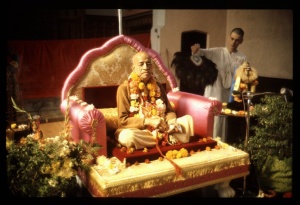SB 10.6.33: Difference between revisions
m (1 revision(s)) |
(Vanibot #0018 edit: make synonym terms in Sanskrit italic in SB - Vanisource) |
||
| Line 1: | Line 1: | ||
{{info | {{info | ||
|speaker= | |speaker=Śukadeva Gosvāmī | ||
|listener=King | |listener=King Parīkṣit | ||
}} | }} | ||
[[Category:Srimad-Bhagavatam - Canto 10 Chapter 06]] | |||
[[Category:Bhagavatam Verses Spoken by Sukadeva Gosvami - Vanisource|100633]] | |||
<div style="float:left">'''[[Srimad-Bhagavatam]] - [[SB 10|Tenth Canto]] - [[SB 10.6: The Killing of the Demon Putana|Chapter 6: The Killing of the Demon Pūtanā]]'''</div> | |||
<div style="float:right">[[File:Go-previous.png|link=SB 10.6.32]] '''[[SB 10.6.32]] - [[SB 10.6.34]]''' [[File:Go-next.png|link=SB 10.6.34]]</div> | |||
{{RandomImage}} | |||
==== TEXT 33 ==== | ==== TEXT 33 ==== | ||
<div | <div class="verse"> | ||
kalevaraṁ paraśubhiś | :kalevaraṁ paraśubhiś | ||
chittvā tat te vrajaukasaḥ | :chittvā tat te vrajaukasaḥ | ||
dūre kṣiptvāvayavaśo | :dūre kṣiptvāvayavaśo | ||
nyadahan kāṣṭha-veṣṭitam | :nyadahan kāṣṭha-veṣṭitam | ||
</div> | </div> | ||
| Line 17: | Line 22: | ||
==== SYNONYMS ==== | ==== SYNONYMS ==== | ||
<div | <div class="synonyms"> | ||
''kalevaram''—the gigantic body of Pūtanā; ''paraśubhiḥ''—with the aid of axes; ''chittvā''—after cutting to pieces; ''tat''—that (body); ''te''—all of those; ''vraja-okasaḥ''—inhabitants of Vraja; ''dūre''—far, far away; ''kṣiptvā''—after throwing; ''avayavaśaḥ''—different parts of the body, piece by piece; ''nyadahan''—burned to ashes; ''kāṣṭha-veṣṭitam''—covered by wood. | |||
</div> | </div> | ||
| Line 24: | Line 29: | ||
==== TRANSLATION ==== | ==== TRANSLATION ==== | ||
<div | <div class="translation"> | ||
The inhabitants of Vraja cut the gigantic body of Pūtanā into pieces with the help of axes. Then they threw the pieces far away, covered them with wood and burned them to ashes. | The inhabitants of Vraja cut the gigantic body of Pūtanā into pieces with the help of axes. Then they threw the pieces far away, covered them with wood and burned them to ashes. | ||
</div> | </div> | ||
| Line 31: | Line 36: | ||
==== PURPORT ==== | ==== PURPORT ==== | ||
<div | <div class="purport"> | ||
It is the practice that after a snake has been killed, its body is cut into various pieces for fear that it may come to life again simply by interacting with air. Merely killing a serpent is not sufficient; after it is killed, it must be cut to pieces and burned, and then the danger will be over. Pūtanā resembled a great serpent, and therefore the cowherd men took the same precautions by burning her body to ashes. | It is the practice that after a snake has been killed, its body is cut into various pieces for fear that it may come to life again simply by interacting with air. Merely killing a serpent is not sufficient; after it is killed, it must be cut to pieces and burned, and then the danger will be over. Pūtanā resembled a great serpent, and therefore the cowherd men took the same precautions by burning her body to ashes. | ||
</div> | </div> | ||
__NOTOC__ | |||
<div style="float:right; clear:both;">[[File:Go-previous.png|link=SB 10.6.32]] '''[[SB 10.6.32]] - [[SB 10.6.34]]''' [[File:Go-next.png|link=SB 10.6.34]]</div> | |||
__NOTOC__ | |||
__NOEDITSECTION__ | |||
Revision as of 11:32, 1 December 2017

A.C. Bhaktivedanta Swami Prabhupada
TEXT 33
- kalevaraṁ paraśubhiś
- chittvā tat te vrajaukasaḥ
- dūre kṣiptvāvayavaśo
- nyadahan kāṣṭha-veṣṭitam
SYNONYMS
kalevaram—the gigantic body of Pūtanā; paraśubhiḥ—with the aid of axes; chittvā—after cutting to pieces; tat—that (body); te—all of those; vraja-okasaḥ—inhabitants of Vraja; dūre—far, far away; kṣiptvā—after throwing; avayavaśaḥ—different parts of the body, piece by piece; nyadahan—burned to ashes; kāṣṭha-veṣṭitam—covered by wood.
TRANSLATION
The inhabitants of Vraja cut the gigantic body of Pūtanā into pieces with the help of axes. Then they threw the pieces far away, covered them with wood and burned them to ashes.
PURPORT
It is the practice that after a snake has been killed, its body is cut into various pieces for fear that it may come to life again simply by interacting with air. Merely killing a serpent is not sufficient; after it is killed, it must be cut to pieces and burned, and then the danger will be over. Pūtanā resembled a great serpent, and therefore the cowherd men took the same precautions by burning her body to ashes.